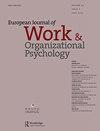在家随(出)心流:远程工作时心流和表现的日常变化
IF 4
2区 心理学
Q2 MANAGEMENT
European Journal of Work and Organizational Psychology
Pub Date : 2023-05-13
DOI:10.1080/1359432X.2023.2211271
引用次数: 0
摘要
先前的研究表明,远程办公往往与更高的工作绩效有关。然而,这项研究主要是将远程工作的天数视为彼此可以互换的。鉴于最近远程办公的激增,重要的是要问一下,在家工作的日子里,员工的表现有多大差异,以及哪些心理和环境因素解释了这种个人差异。这些信息可以帮助组织决定如何最好地实施政策并支持在家工作的员工。在这里,我们认为干扰和社会隔离是远程工作时实现心流的障碍,因此,在那些日子里,较高的日常水平会阻碍心流。反过来,这种心流的缺乏应该与远程工作时的日常表现恶化有关。为了调查这些想法,我们要求97名远程工作者在长达四天的时间里(296个数据点)对一系列日常措施做出回应。结果表明,远程办公员工的工作绩效在不同工作日之间存在显著差异,日常干扰和日常隔离均对工作心流产生负向预测,这进一步介导了干扰与工作绩效降低之间的关系。隔离并没有显著调节这种关系。此外,有责任心的人尤其能够利用更高的心流来提高绩效。我们讨论了这些结果的含义。本文章由计算机程序翻译,如有差异,请以英文原文为准。
Going with(out) the flow at home: day-to-day variability in flow and performance while teleworking
ABSTRACT Prior research suggests that telework often is associated with higher job performance. However, this research primarily has treated days teleworking as interchangeable with one another. Given the recent surge in telework, it is important to ask how much performance varies among days spent working at home and what psychological and contextual factors explain such within-person variability. This information can assist organizations deciding how to best implement policies and support workers at home. Here, we suggest that intrusions and social isolation are obstacles to achieving flow while teleworking, such that higher daily levels of each will hinder flow on those days. In turn, this lack of flow should be associated with worsened daily performance while teleworking. To investigate these ideas, we asked 97 teleworkers to respond to a series of daily measures for up to four days (296 data points). Results showed that performance varied significantly among teleworking days, with both daily intrusions and daily isolation negatively predicting flow, which further mediated the relationship between intrusions and reduced task performance. Isolation did not significantly mediate this relationship. Moreover, conscientious individuals were especially able to leverage higher flow for performance. We discuss implications of these results.
求助全文
通过发布文献求助,成功后即可免费获取论文全文。
去求助
来源期刊
CiteScore
8.00
自引率
2.30%
发文量
40
期刊介绍:
The mission of the European Journal of Work and Organizational Psychology is to promote and support the development of Work and Organizational Psychology by publishing high-quality scientific articles that improve our understanding of phenomena occurring in work and organizational settings. The journal publishes empirical, theoretical, methodological, and review articles that are relevant to real-world situations. The journal has a world-wide authorship, readership and editorial board. Submissions from all around the world are invited.

 求助内容:
求助内容: 应助结果提醒方式:
应助结果提醒方式:


